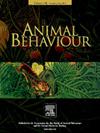No evidence of kin preferences in a feral horse multilevel society
IF 2.3
2区 生物学
Q2 BEHAVIORAL SCIENCES
引用次数: 0
Abstract
A multilevel society represents a complex social structure characterized by nested levels of social organization, where small core units aggregate to form higher-level social organizations. In such a society, kinship often plays an important role in shaping social relationships; however, the degree of kin preference differs among species. This study aimed to identify whether free-ranging horses, Equus ferus caballus, in Serra D'Arga, Portugal, which form a two-tiered society, show preferences for related individuals. We examined the genetic relatedness of 167 genotyped individuals, which were in reproductive age, over a 7-year period and compared it with the unit composition and interunit proximity/association data obtained from drone observations. Neither relatedness nor the direct evaluation of first-degree relatives showed any clear correlation with either intra- or interunit relationships. This finding represents the first documented case of absence of kin preference in a multilevel society. It suggests that a multilevel society could be established without bonds among relatives and emphasizes the need to investigate nonkin relationship formation. This observed tendency differs from that of a related species, the plains zebra, Equus quagga, which has been reported to exhibit a female–female kin preference. Further comparisons with other equine species or different taxonomic groups are necessary to reveal the factors that influence genetic-related structures in a multilevel society.
求助全文
约1分钟内获得全文
求助全文
来源期刊

Animal Behaviour
生物-动物学
CiteScore
4.60
自引率
8.00%
发文量
236
审稿时长
10.2 weeks
期刊介绍:
Growing interest in behavioural biology and the international reputation of Animal Behaviour prompted an expansion to monthly publication in 1989. Animal Behaviour continues to be the journal of choice for biologists, ethologists, psychologists, physiologists, and veterinarians with an interest in the subject.
 求助内容:
求助内容: 应助结果提醒方式:
应助结果提醒方式:


